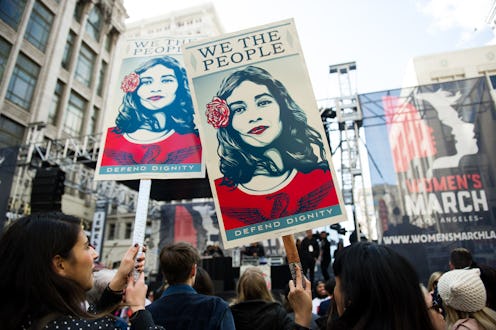Life
What Is The Women's Strike Protesting?

On Tuesday, the team behind the Women’s March on Washington announced a date for “A Day Without A Woman.” The strike will take place March 8 — also the date of International Women’s Day. In the last few days, organizers have released further details about what the women’s strike is protesting and what agenda the strike is seeking to support.
The Women’s March website declares that the women’s strike will be a day in which “women and our allies will act together creatively to withdraw from the corporations that harm us and find ways to support the businesses, organizations and communities that sustain us.” The organizers ask supporters to consider three key questions:
1. Do businesses support our communities, or do they drain our communities?
2. Do they strive for gender equity or do they support the policies and leaders that perpetuate oppression?
3. Do they align with a sustainable environment or do they profit off destruction and steal the futures of our children?
The webpage for “A Day Without A Woman” orients the strike largely as positive actions — situating it in terms of supporting the businesses that support communities — and doesn’t linger heavily on what the strike is protesting against. However, we can look to the mission statement of the Women’s March for a clearer picture of what the strike is attempting to combat:
The rhetoric of the past election cycle has insulted, demonized, and threatened many of us — immigrants of all statuses, Muslims and those of diverse religious faiths, people who identify as LGBTQIA, Native people, Black and Brown people, people with disabilities, survivors of sexual assault — and our communities are hurting and scared. We are confronted with the question of how to move forward in the face of national and international concern and fear.
It’s safe to assume that the unifying principle undergirding the Women’s March is also that of the women’s strike:
We must create a society in which women — including Black women, Native women, poor women, immigrant women, disabled women, Muslim women, lesbian queer and trans women — are free and able to care for and nurture their families, however they are formed, in safe and healthy environments free from structural impediments.
In the weeks ahead, organizers say that they will elaborate on the shape that the strike will take. For some, taking part in “A Day Without A Woman” may mean choosing not to go to work and participating in some form of volunteering or community activism instead; for others, it might mean refusing to spend money altogether, or to only shop at businesses that support equal rights and opportunities for all. All of these actions are meant to further “the fight for economic justice”— hopefully by demonstrating how integral women are to the U.S. labor force and economy.